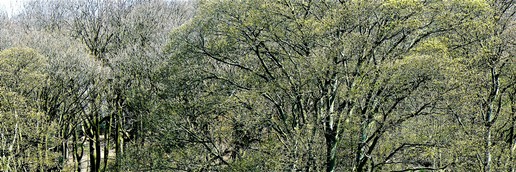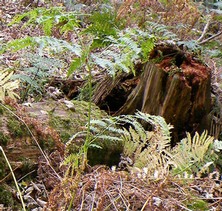

Biodiversity
Action
Plan

A complex structure of trees and shrubs with younger trees alongside older trees with a good, spreading structure, some low branches and a complex canopy, increases biodiversity.
Woodland edges and places where woodland grades into open scrub, sheltered glades and rides, and grassland are important for a range of wildlife species such as butterflies which use both the trees and shrubs and the grasses and flowering plants found in more open areas.
Butterflies, moths and other insects often require specific species of tree, shrub and ground cover as larval food plants. The locally rare Purple Hairstreak Butterfly is found on Oak, White Letter Hairstreak found on Elm and other butterflies depend on grasses and other plants found in wide rides and glades.
1256 woodland species were studied in the 2013 State of Nature report.
60% had suffered overall declines and 34% decreased strongly.
A few - like Buzzard and Great Spotted Woodpecker - increased.
Species in Barnsley woodland
Bat species. Most bats use woodland for roosting or foraging. Roosts of Soprano Pipistrelle, Natterer’s, Noctule and Brown Long-eared Bats are usually in or near trees or a woodland.
Other mammals in woodland habitats include deer, Fox, Badger, Hedgehog, as well as mice, voles and shrews.
Birds breeding in woodland include:
- the red listed Hawfinch, Lesser Spotted Woodpecker, Lesser Redpoll, Tree Pipit, Willow Tit, Woodcock and Wood Warbler with Bullfinch, Spotted Flycatcher and Song Thrush;
- the amber listed Green Woodpecker, Pied Flycatcher, and Redstart;
- as well as Great Spotted Woodpecker, Nuthatch, Tree Creeper, Jay, Tawny Owl and Buzzard.
.
Invertebrates. Woodland supports a wide range of insects and other invertebrates, including centipedes, woodlice and millipedes, ants, flies, bees, moths and butterflies.
Many butterflies and moths are regularly found in woodland and specific woodland butterflies include Speckled Wood, Comma, Ringlet, Purple Hairstreak and White-lettered Hairstreak.
White-letter Hairstreak; macromoth, Yellow-legged Clearwing; and longhorn beetle, Stenocorus meridianus, have been found in Hugset wood for example.
Plants. See overview and forthcoming page on ancient woodland indicators.
Mixed Deciduous Woodland Habitat Features
Mixed Deciduous Woodland supports the most wildlife species if it is diverse in structure. Open soil, leaf litter, older and younger trees, scrub, standing and fallen dead wood, and a variety of plant ground cover: each feature adds to the range of species supported.

Fungi often grow on dead and decaying wood and assist the decay process. In turn the rotten wood and leaf litter support a range of invertebrates and the birds that feed on them.
Such dead, decayed or decaying wood can be found in the form of standing trees; dead branches, stems and snags on living trees; and fallen branches and stumps.

Note: The Woodland Wildlife Toolkit published online in early 2019 includes fact sheets on individual species dependent on woodland and gives information on woodland habitat features and ways of managing them for wildlife.
Deciduous Woodland Features